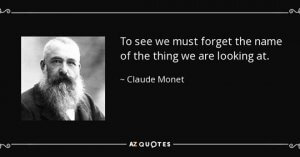“Who am I anyway? Am I my resume?” from A Chorus Line
 What is in our identity that makes us who we are? What is it in a person’s face, that if we capture it, we call it a likeness? People boast, “I never forget a face.” What is it in a face that is so unforgettable? I was just looking at ole what’s her name, wondering the same thing! Seriously, I remember a face but the name often escapes me. So what’s in a name, you ask? A Rose is a Rose, is a Rose.
What is in our identity that makes us who we are? What is it in a person’s face, that if we capture it, we call it a likeness? People boast, “I never forget a face.” What is it in a face that is so unforgettable? I was just looking at ole what’s her name, wondering the same thing! Seriously, I remember a face but the name often escapes me. So what’s in a name, you ask? A Rose is a Rose, is a Rose.
Is it reasonable to say that to love something, we must see beyond its identity. In fact, to love a thing means we are not limited by its identity. We are far more than our name, age, job, weight, income level, IQ, sex or color. We are something far deeper and more splendid. And yet, we are all of the same stuff. “Those eyes, those lips, those nose!” We only seem to be different and separate. Actually, we are all the same but we are all different.
As a representational artist, it is my job to distill the essence from what I’m seeing, that which is most true in a thing. In every line and every stroke I am making a multitude of decisions and revisions. I am including what I believe is most important and leaving out what isn’t. What Monet was referring to is related more to the painting process, than the deep philosophical stuff above.
I tell my students I’ve painted over 80,000 faces in my life, but I’ve never painted an eye or a nose or a mouth. As an artist, it is my job to transform the images I see into the language of painting. A likeness is the result of the careful arrangement of these shapes and colors into something people recognize as my subject.
The Six Elements of the Master Stroke
So what is the essence? What is my sole focus in each and every stroke of paint? I must determine the 1) exact shape of the stroke, what I call the envelope 2) it’s position in relation to other shapes, it’s 3) relative value, 4) chroma and 5) and hue, and finally, the 6) edge quality of that particular shape as it connects or transitions into other shapes.
The way you interpret/execute these six elements is what makes your work different from mine or anyone else’s. There are a million possible outcomes for every stroke of paint. The key, as Monet points out so astutely, is not to paint the named thing. That is the road to misery. Because what you see will always be in conflict with what you “know” to be true about the thing you are painting. Rather, learn to abstract or distill shapes into their nameless essences as they appear to you right now. The right brain perceives and the left brain conceives. Representational artists need to develop their left brain.


 Would you like to get inspiration in your inbox, rather than ads for more stuff? Welcome to ManiscalcoGallery.com
Would you like to get inspiration in your inbox, rather than ads for more stuff? Welcome to ManiscalcoGallery.com